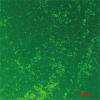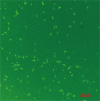Adherence of Candida to complete denture surfaces in vitro: A comparison of conventional and CAD/CAM complete dentures
- PMID: 29142649
- PMCID: PMC5673618
- DOI: 10.4047/jap.2017.9.5.402
Adherence of Candida to complete denture surfaces in vitro: A comparison of conventional and CAD/CAM complete dentures
Abstract
Purpose: The goal of this study was to compare the adhesion of Candida albicans to the surfaces of CAD/CAM and conventionally fabricated complete denture bases.
Materials and methods: Twenty discs of acrylic resin poly (methyl methacrylate) were fabricated with CAD/CAM and conventional procedures (heat-polymerized acrylic resin). The specimens were divided into two groups: 10 discs were fabricated using the CAD/CAM procedure (Wieland Digital Denture Ivoclar Vivadent), and 10 discs were fabricated using a conventional flasking and pressure-pack technique. Candida colonization was performed on all the specimens using four Candida albicans isolates. The difference in Candida albicans adhesion on the discs was evaluated. The number of adherent yeast cells was calculated by the colony-forming units (CFU) and by Fluorescence microscopy.
Results: There was a significant difference in the adhesion of Candida albicans to the complete denture bases created with CAD/CAM and the adhesion to those created with the conventional procedure. The CAD/CAM denture bases exhibited less adhesion of Candida albicans than did the denture bases created with the conventional procedure (P<.05).
Conclusion: The CAD/CAM procedure for fabricating complete dentures showed promising potential for reducing the adherence of Candida to the denture base surface. Clinical Implications. Complete dentures made with the CAD/CAM procedure might decrease the incidence of denture stomatitis compared with conventional dentures.
Keywords: Adhesion; CAD/CAM; Candida; Complete denture; Edentulous; Roughness.
Figures




Similar articles
-
Candida albicans colonization on CAD-CAM denture resin surface.J Dent. 2025 Jun;157:105756. doi: 10.1016/j.jdent.2025.105756. Epub 2025 Apr 11. J Dent. 2025. PMID: 40222702
-
Physical, Mechanical, and Anti-Biofilm Formation Properties of CAD-CAM Milled or 3D Printed Denture Base Resins: In Vitro Analysis.J Prosthodont. 2023 Apr;32(S1):38-44. doi: 10.1111/jopr.13554. Epub 2022 Jul 9. J Prosthodont. 2023. PMID: 35661475
-
CAD/CAM produces dentures with improved fit.Clin Oral Investig. 2018 Nov;22(8):2829-2835. doi: 10.1007/s00784-018-2369-2. Epub 2018 Feb 22. Clin Oral Investig. 2018. PMID: 29468600
-
Adhesion of Candida Albicans to digital versus conventional acrylic resins: a systematic review and meta-analysis.BMC Oral Health. 2024 Mar 4;24(1):303. doi: 10.1186/s12903-024-04083-2. BMC Oral Health. 2024. PMID: 38439020 Free PMC article.
-
A systematic review of digital removable partial dentures. Part II: CAD/CAM framework, artificial teeth, and denture base.J Prosthodont Res. 2022 Jan 11;66(1):53-67. doi: 10.2186/jpr.JPR_D_20_00117. Epub 2021 Jan 26. J Prosthodont Res. 2022. PMID: 33504722
Cited by
-
In vitro study of surface properties and microbial adhesion of various dental polymers fabricated by different manufacturing techniques after thermocycling.Clin Oral Investig. 2022 Dec;26(12):7287-7297. doi: 10.1007/s00784-022-04689-2. Epub 2022 Aug 17. Clin Oral Investig. 2022. PMID: 35976495
-
Experimental Study on Mechanical Properties of Different Resins Used in Oral Environments.Medicina (Kaunas). 2023 May 28;59(6):1042. doi: 10.3390/medicina59061042. Medicina (Kaunas). 2023. PMID: 37374246 Free PMC article.
-
Evaluation of polymethyl-methacrylate and acetal denture base resins processed by two different techniques before and after nano-chlorohexidine surface treatment.BMC Oral Health. 2023 Dec 8;23(1):985. doi: 10.1186/s12903-023-03718-0. BMC Oral Health. 2023. PMID: 38066495 Free PMC article.
-
Evaluation of biofilm formation on acrylic resins used to fabricate dental temporary restorations with the use of 3D printing technology.BMC Oral Health. 2022 Oct 13;22(1):442. doi: 10.1186/s12903-022-02488-5. BMC Oral Health. 2022. PMID: 36229871 Free PMC article.
-
Fibrin Biopolymer Incorporated with Antimicrobial Agents: A Proposal for Coating Denture Bases.Materials (Basel). 2021 Mar 26;14(7):1618. doi: 10.3390/ma14071618. Materials (Basel). 2021. PMID: 33810381 Free PMC article.
References
-
- Cunha-Cruz J, Hujoel PP, Nadanovsky P. Secular trends in socio-economic disparities in edentulism: USA, 1972-2001. J Dent Res. 2007;86:131–136. - PubMed
-
- Dye BA, Li X, Thorton-Evans G. Oral health disparities as determined by selected healthy people 2020 oral health objectives for the United States, 2009-2010. NCHS Data Brief. 2012;(104):1–8. - PubMed
-
- Douglass CW, Shih A, Ostry L. Will there be a need for complete dentures in the United States in 2020? J Prosthet Dent. 2002;87:5–8. - PubMed
-
- Gotfredsen K, Walls AW. What dentition assures oral function? Clin Oral Implants Res. 2007;18:34–45. - PubMed
LinkOut - more resources
Full Text Sources
Other Literature Sources
Miscellaneous

